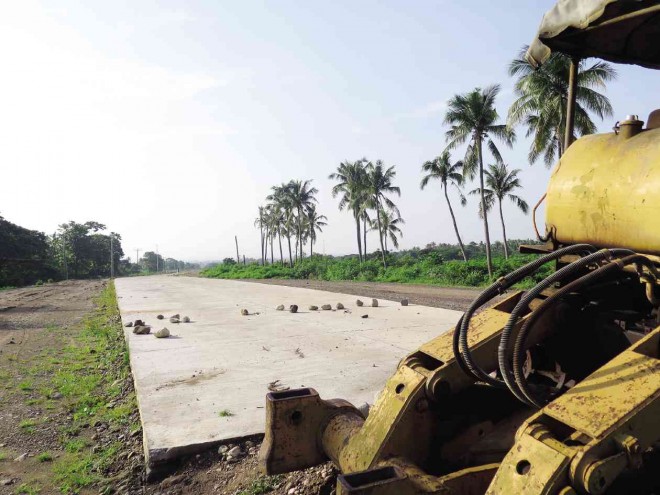
A PORTION of the Sariaya bypass road that had been finished in the village of Sampaloc Dos along the Maharlika Highway DELFIN MALLARI JR/INQUIRER SOUTHERN LUZON
LUCENA CITY—Lucena Bishop Emilio Marquez has declared support for the government road project in Sariaya town that has been the subject of protests by historical conservation groups.
“The town really needs loading and unloading bays. The project is important to address the traffic problem in Sariaya,” said Marquez in an interview on Saturday.
Marquez said he believed that Sariaya, which had long been plagued by traffic bottlenecks, would benefit from the construction of loading and unloading stations for public utility vehicles.
When reminded that there are three alternative road projects that would divert motorists from the Sariaya town center, Marquez said he still believed in the benefits of the stations now being built by the Department of Public Works and Highways (DPWH).
“Why continue to punish the people and motorists with traffic problems? Even after the completion of the alternative roads, the loading and unloading bays would still serve their purpose,” said Marquez.
The three alternative road systems are the 24.7-km Quezon-Batangas eco-tourism road, 7-km Sariaya bypass road and the 57-km and 4-lane South Luzon Expressway (SLEx) extension linking Sto. Tomas in Batangas and Lucena City.
The ecotourism road would be finished by early next year at the latest while the Sariaya bypass road’s completion is set in 2017. The SLEx extension is to be finished in 2019.
A PORTION of the Sariaya bypass road that had been finished in the village of Sampaloc Dos along the Maharlika Highway DELFIN MALLARI JR/INQUIRER SOUTHERN LUZON
The Sariaya road project met strong opposition from the Sariaya Heritage Council Inc. and owners of heritage houses along the route.
On March 18, the National Commission for Culture and the Arts (NCCA) issued a cease-and-desist order against the road project, which its critics said would damage portions of a heritage house, the municipal hall and plaza and a parish church.
The opposition forced the DPWH to revise the plan and settle for three loading and unloading stations on the main road—the market area, middle of General Luna Street and in front of the town plaza.
But conservationists continue to oppose the revised plan and launched an online petition to stop the digging for the road project.
Nestor Cleofas, head of the DPWH-Quezon second district based in Lucena, said the project would not touch structures that are covered by the NCCA order.
The Inquirer found the digging site to be two blocks away from the Enriquez-Gala mansion, town plaza and the Catholic church.
Marquez said the plaza site is owned by the Church. “And I’m allowing the DPWH to use a portion of it for their project,” he said.